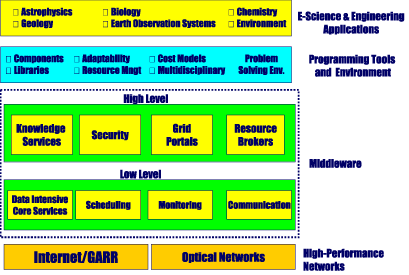|
|||
Grid.it - Next Generation Grid Platforms and their Applicationsby Domenico Laforenza and Marco Vanneschi Grid.it is a strategic project in the area of Enabling Technologies for the Information Society, coordinated by the Italian National Research Council. The project has a strong interdisciplinary character and is aimed at defining, implementing and applying innovative solutions for networked computing-enabling platforms, oriented towards scalable virtual organisations and based on the 'Grid Computing' paradigm. The research topics in the project span from high performance photonic networks to innovative middleware services, high-performance programming environments and so forth. Moving on from the distributed platform based on a distributed infrastructure scenario, Grid.it places special emphasis on the high performance requirements of applications developed on the Grid. This means that the integration of systems and resources, as well as heterogeneity and dynamic situations management, must explicitly handle the case of Grid nodes (which in general are geographically distributed or located on private virtual networks) as high performance systems, such as parallel machine architectures or clusters. Research on high performance extends to all the platform levels, from high bandwidth networks to middleware services and, in particular, to resource management as well as tools and programming environments. At the programming tools and environment level the high performance requirement implies that, when designing scalable virtual organisations (VOs), a unifying approach should be used. This approach takes into account both aspects related to the distribution of computations and resources, and those related to parallelism. The programming environment must therefore be characterized by a high degree of portability on different hardware-software systems (or different hardware-software combinations) in a heterogeneous and dynamic context. Portability must be guaranteed not only for code but should also ensure that the performance matches the configuration of the target system at hand. Tool interoperability and high performance application reuse are also fundamental to the programming environment. At the middleware level, research on resource management includes aspects of maximum importance such as discovery, brokering, scheduling, monitoring and performance evaluation/ prediction. The study of the high speed networks needed to support enabling Grid platforms for scalable VOs is an internationally recognized 'hot' topic. Within this research activity an important role is played by experiments on very high bandwidth optical networks, based on photonic technology for Grid platforms with high performance sites that extend to the metropolitan area. In addition to aspects concerning programming environments and resource management, the software technology studied in Grid.it includes some fundamental aspects related to middleware:
Applications
In order to be able to implement and experiment the ideas and results of the project, a Grid infrastructure will be implemented on a national scale, based on the GARR network and using, in some metropolitan sites, optical fiber interconnections. This project result will provide the community with a national Grid that can be used in different computational science research sectors, and also for commerce, industrial and social service applications. Organisation The Grid.it project aims at playing an important role in the training of highly qualified young people. A relevant part of the project budget is reserved for contracts for young researchers. Link: Please contact: Marco Vanneschi, Pisa University, Italy |
|||



